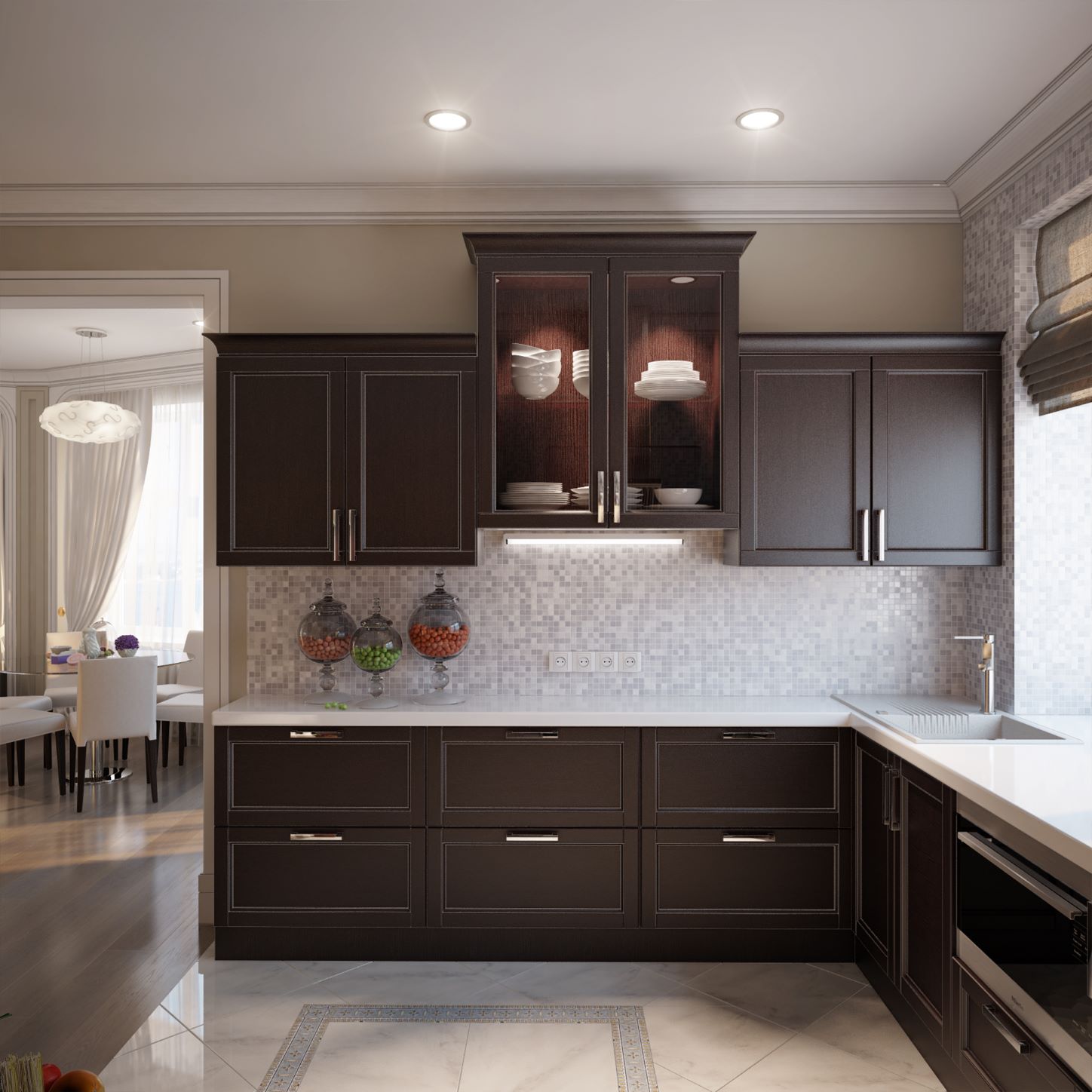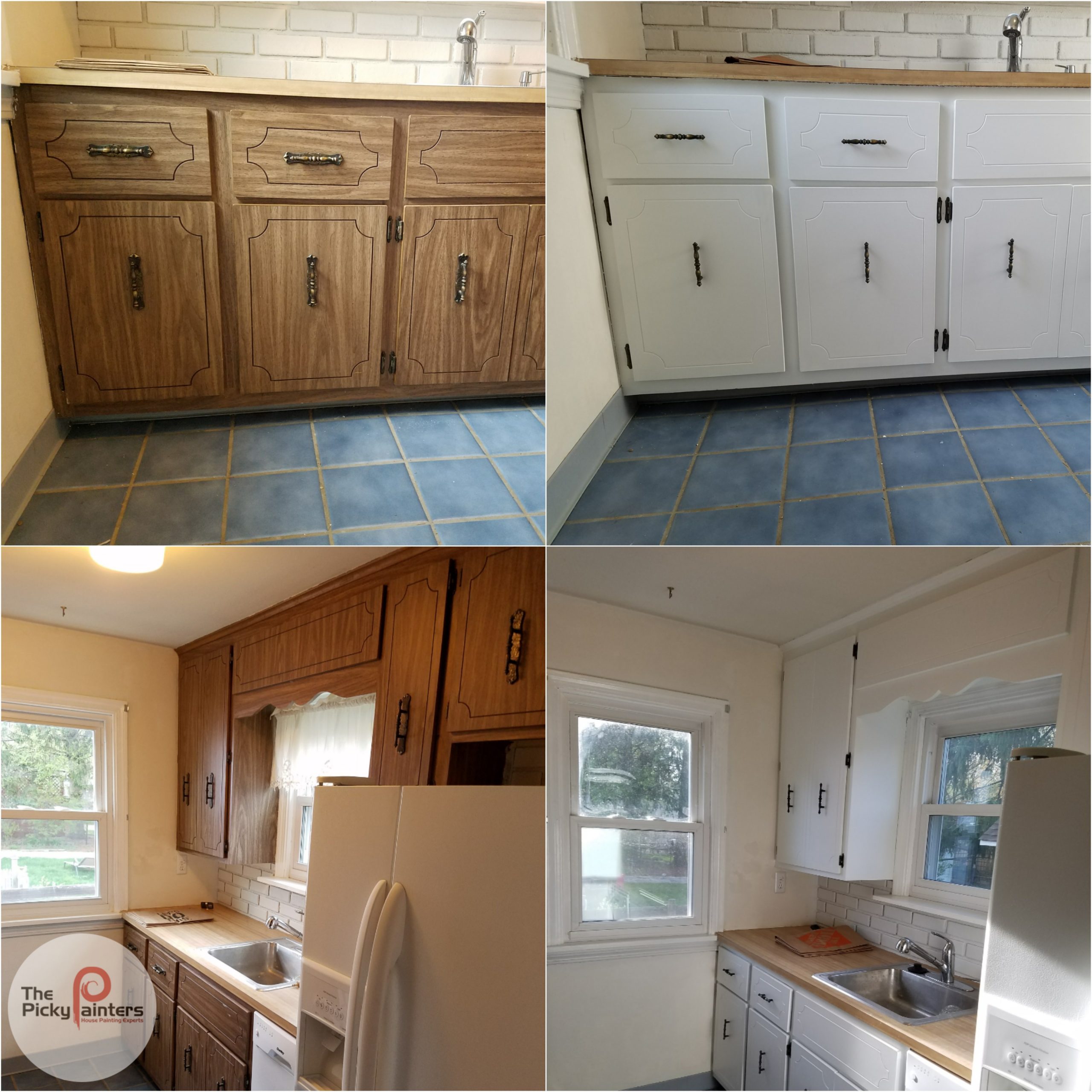Surface Preparation for Laminate Cabinets

Proper surface preparation is paramount for achieving a durable and aesthetically pleasing paint finish on laminate kitchen cabinets. Failing to adequately prepare the surface will result in poor paint adhesion, chipping, peeling, and an overall unsatisfactory outcome. This section details the crucial steps involved in cleaning, deglossing, and sanding laminate cabinets before painting, ensuring optimal paint adherence.
Cleaning Laminate Cabinets
Effective cleaning removes grease, dirt, and other contaminants that can hinder paint adhesion. A variety of cleaning solutions can be used, each with varying degrees of effectiveness. The choice depends on the level of soiling and the type of laminate.
| Cleaning Solution | Effectiveness | Pros | Cons |
|---|---|---|---|
| Warm soapy water | Good for light cleaning | Gentle, readily available, inexpensive | May not remove stubborn grease or grime |
| Degreasing solution (e.g., TSP substitute) | Excellent for removing grease and grime | Effectively cleans deeply, improves paint adhesion | Can be harsh, requires thorough rinsing |
| Isopropyl alcohol (rubbing alcohol) | Good for removing sticky residues | Effective, evaporates quickly, leaves no residue | May not be effective on heavy grease |
| Commercial laminate cleaner | Varies depending on the product | Specifically formulated for laminate, may offer additional benefits | Can be expensive, check for compatibility with paint |
Deglossing and Sanding Laminate Cabinets, Best way to paint laminate kitchen cabinets
Laminate surfaces are typically very smooth and glossy, which prevents paint from adhering properly. Deglossing is the process of reducing the glossiness of the surface to create better mechanical bonding for the paint. This is usually achieved through sanding, but chemical deglossers are also available. Proper sanding techniques are essential to avoid damaging the laminate surface.
Best way to paint laminate kitchen cabinets – Sanding should be performed using fine-grit sandpaper (starting with 180-grit and progressing to 220-grit) to create a slightly roughened surface, enhancing paint adhesion. Always sand in the direction of the wood grain (if visible) using light, even strokes. Avoid excessive pressure, which can scratch or gouge the laminate. After sanding, thoroughly remove all dust particles using a tack cloth or a slightly damp cloth.
Primer Selection for Laminate Surfaces
Applying a primer specifically formulated for laminate surfaces is crucial. This creates a better bonding surface for the topcoat and helps prevent the paint from chipping or peeling. Several primer types are available, each with unique characteristics.
The choice of primer depends on several factors, including the type of laminate, the desired finish, and the type of paint being used. Consider these options:
- Adhesion Promoters: These primers are designed to enhance the bonding of paint to difficult surfaces like laminate. They often contain specialized resins that create a strong mechanical bond. Example: Kilz Adhesion Primer.
- Oil-Based Primers: These primers offer excellent adhesion and blocking properties, effectively sealing stains and preventing them from bleeding through the topcoat. However, they have a strong odor and require longer drying times. Example: Benjamin Moore Fresh Start Primer.
- Water-Based Primers: These primers are low-odor, easy to clean up, and dry quickly. They are a good choice for environmentally conscious projects. However, they may not offer the same level of adhesion as oil-based primers. Example: Sherwin-Williams ProClassic Interior Acrylic Primer.
- Specialty Laminate Primers: These primers are specifically formulated for use on laminate surfaces, providing superior adhesion and durability. They often contain bonding agents that create a strong bond with the laminate. Example: Rust-Oleum Painter’s Touch 2X Ultra Cover Primer.
Paint Selection and Application Techniques

Choosing the right paint and applying it correctly are crucial for achieving a professional-looking finish on your laminate kitchen cabinets. The type of paint you select will significantly impact the durability and appearance of your final project. Proper application techniques ensure a smooth, even coat that resists chipping and peeling, maximizing the lifespan of your refreshed cabinets.
Paint Type Comparison: Oil-Based vs. Water-Based
Oil-based paints offer superior durability and adhesion, making them a popular choice for high-traffic areas like kitchens. They tend to produce a harder, more resistant finish that better withstands scratches and moisture. However, oil-based paints have a strong odor, require longer drying times, and necessitate the use of solvents for cleanup. Water-based (latex) paints, conversely, are low-odor, dry quickly, and are easily cleaned up with soap and water. While generally less durable than oil-based paints, advancements in latex technology have produced formulations that provide excellent durability and are suitable for kitchen cabinets. The choice ultimately depends on your priorities regarding durability, convenience, and environmental concerns.
Paint Sheen Options and Suitability for Kitchens
The sheen of your paint significantly impacts its appearance and practicality in a kitchen environment. Different sheens offer varying levels of durability and stain resistance.
| Sheen | Description | Suitability for Kitchens |
|---|---|---|
| Flat/Matte | Minimal shine, hides imperfections well. | Not ideal for kitchens due to low durability and stain resistance. |
| Eggshell | Slightly more sheen than matte, easy to clean. | A good compromise between durability and hiding imperfections. |
| Satin | Moderate shine, durable and easy to clean. | A popular choice for kitchens due to its balance of durability and aesthetics. |
| Semi-Gloss | High shine, very durable and easy to clean. | Excellent choice for high-traffic areas and prone-to-moisture areas like kitchen cabinets. |
| Gloss | High shine, very durable and easy to clean, shows imperfections easily. | Provides maximum durability but highlights surface imperfections. |
Applying Paint to Laminate Cabinets: Techniques for a Smooth Finish
Before applying paint, ensure your cabinets are thoroughly cleaned and primed using a primer specifically designed for laminate surfaces. This primer will improve adhesion and provide a uniform base for the paint. For applying paint, both brushes and rollers can be used effectively. High-quality brushes with synthetic bristles are recommended for edges and detail work, allowing for precise application and minimizing brushstrokes. A good quality roller with a short nap is ideal for larger surfaces, providing a smooth, even coat. Employ a “W” pattern with the roller to avoid lap marks. For edges and corners, use a small angled brush or a foam brush for precise application, ensuring complete coverage without drips or runs. Multiple thin coats are always preferable to one thick coat, allowing each layer to dry properly and preventing runs.
Multiple Coats: Drying Times and Techniques to Prevent Drips and Runs
Allow each coat of paint to dry completely before applying the next. Drying times vary depending on the paint type, temperature, and humidity. Always refer to the manufacturer’s instructions for specific drying times. To prevent drips and runs, apply thin, even coats using a light touch. Avoid overloading your brush or roller. If drips or runs do occur, immediately smooth them out with a clean, damp brush before the paint dries. Using a high-quality paint and following the manufacturer’s instructions will significantly reduce the likelihood of drips and runs. A professional-looking finish is achieved through patience and attention to detail. Sand lightly between coats with fine-grit sandpaper (220-grit or higher) to create a smooth surface for the next coat. This step is crucial for a flawless, even finish.
Addressing Common Challenges and Troubleshooting: Best Way To Paint Laminate Kitchen Cabinets

Painting laminate cabinets can present unique challenges. The non-porous surface of laminate requires careful preparation and technique to ensure a durable, attractive finish. Understanding common problems and their solutions is crucial for a successful project.
Common Problems and Solutions
Many issues arise when painting laminate cabinets. These problems often stem from inadequate preparation or incorrect application techniques. The following table summarizes common problems, their causes, and effective solutions.
| Problem | Cause | Solution |
|---|---|---|
| Peeling Paint | Insufficient surface cleaning and preparation; poor adhesion of primer or paint; using unsuitable paint type. | Thoroughly clean and degrease the cabinets. Apply a high-quality bonding primer designed for laminate surfaces. Ensure proper drying time between primer and paint coats. Use a paint specifically formulated for adhesion to glossy surfaces. |
| Chipping Paint | Inadequate surface preparation; thin paint application; impact damage. | Ensure a smooth, even surface before painting. Apply multiple thin coats of paint rather than one thick coat. Consider applying a clear topcoat for added protection against chipping. |
| Uneven Finish | Uneven paint application; insufficient sanding between coats; dust or debris on the surface. | Use a high-quality brush or roller with a smooth, even stroke. Lightly sand between coats to create a smoother surface. Ensure the painting area is clean and free of dust. |
| Bubbling Paint | Moisture trapped beneath the paint; insufficient drying time between coats; applying paint to a damp surface. | Ensure the cabinets are completely dry before painting. Allow adequate drying time between coats. Use a paint that is suitable for the environment and allows for proper ventilation during the drying process. |
| Cracking Paint | Poor adhesion; inflexible paint; movement of the cabinet substrate. | Use a flexible paint or a paint specifically designed for use on laminate. Apply multiple thin coats to allow for flexibility. Address any underlying substrate issues that may be causing movement. |
Addressing Paint Bubbling
Paint bubbling is often caused by trapped moisture or inadequate drying time. If bubbling occurs, carefully scrape away the affected area using a putty knife. Sand the area smooth, clean thoroughly, and reapply primer and paint. Allow ample drying time between coats to prevent recurrence. Proper ventilation is also crucial during the painting process.
Addressing Paint Cracking
Cracking is typically caused by poor adhesion or the use of an inflexible paint on a surface prone to expansion and contraction. Repairing cracked paint involves carefully removing the cracked areas, sanding the surface smooth, applying a bonding primer designed for laminate, and then repainting with a flexible paint formulated for adhesion to glossy surfaces. Multiple thin coats will minimize the risk of further cracking.
